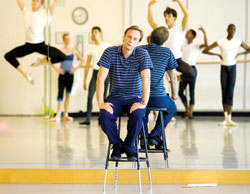Former Pacific Northwest Ballet directors Kent Stowell and Francia Russell spent 28 years building an excellent company that was devoted to the Balanchine tradition, with some 19th-century classics and mainstream modern works thrown in. After a year and a half on the job, Pacific Northwest Ballet’s new artistic director, Peter Boal, has already made it clear that PNB audiences can expect a much broader repertoire, with more guest artists and local choreography. In particular, Boal has planned a weeklong festival this coming April, focusing on choreographers from the Northwest—Robert Joffrey, Merce Cunningham, and Trisha Brown—who haven’t always been well-represented in the PNB repertory.
“A lot of what I program are things that were rewarding for me to experience as a dancer,” says Boal, who spent years with the New York City Ballet, where he was acclaimed as one of the best of his generation. He could have coasted on his technical skills and refined style but was a quiet risk taker as well, searching out modern works to perform with a small group he ran on the side. He has brought this same risk taking to PNB. There are nearly as many examples of “crossover choreography” (amalgams of ballet and postmodern styles), and just plain modern dance, in PNB’s new repertory as there are works from more traditional ballet sources.
These pieces require dancers who can not only perform multiple pirouettes but spin on their backs and swing from the ceiling. Hip-hop choreographer Victor Quijada spent almost as much time working with his cast on their breaking skills this autumn as he spent creating the piece, Suspension of Disbelief. The results were stunning, but pushed the dancers into new physical territory; and with only one cast for the piece, a single injury could have stymied the whole project. Other special skills, like the trapeze work in Susan Marshall’s Kiss from last year, add to an already challenging job for company dancers at a time when they are performing more often and rehearsing more quickly than in the past.
PNB didn’t tour much in the last years of Stowell and Russell: The challenges of building a new school on the Eastside and the renovations to what is now McCaw Hall kept money too tight for that kind of travel. But Boal is committed to sending representatives of the company out into the wider world. PNB dancers have already performed in New York City and Palm Springs as well as Jacob’s Pillow in Massachusetts. It’s a thrilling development, for the dancers and for the overall visibility of Seattle dance, but it’s also more work, adding extra rehearsals on top of regular season responsibilities, when that “regular season” has become even busier.
Stowell and Russell were very protective of the ensemble and turned down offers by touring artists. Boal has a less insular perspective, feeling that the more exposure the dancers get, the better off they are, and the more dancers the audience sees, the better it understands the possibilities of the art form. As he’s mentioned several times in interviews as well as the regular post- performance question-and-answer sessions, he is using his own experiences as a guideline, remembering the subtle sense of competition that a guest artist would bring to company life. And so, he’s bringing in NYCB’s Miranda Weese and award- winning freelancer Rasta Thomas, as well as opening the stage up to other companies for the festival programs in April.
So far, the formula seems to be very successful: Single ticket sales have improved, the audience-education projects he’s initiated or expanded are flourishing (the “$5 Friday” rehearsal/showing programs sell out consistently), the national attention the company received during his first year was glowing, and, closer to home, dancers are excited about their opportunities. When he’s asked about the transition, Boal replies with a laugh, “You want the stump speech? It’s honest, though. I think other people would tell you this, too. It’s a very exciting time for PNB, and it’s a very exciting time for dance in Seattle. There’s a lot happening here; there’s a lot of excitement in the house.”








